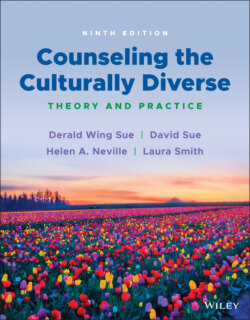Читать книгу Counseling the Culturally Diverse - Laura Smith L. - Страница 30
The Meaning of Defensiveness and Anger
ОглавлениеAlthough defensiveness and anger are two different emotions, studies seem to indicate a high relationship between the two (Apfelbaum, Sommers, & Norton, 2008; Sue, Torino, et al., 2010; Zou & Dickter, 2013). One represents a protective stance and the other an attempt to strike back at the perpetrator (in many cases, statements by People of Color). Note, for example, how one of the White students became angry with the authors and accused them of being racist and propagandistic. In absorbing diversity content, many White students describe feeling defensive (unfairly accused of being biased or racist, blamed for past racial injustices, and responsible for the current state of race relations). “I'm tired of hearing ‘White people this … White people that’ … why are we always blamed for everything?”
When the text discusses bias and bigotry, or when classmates of color bring up the issue, for example, some White students seem to interpret this as a personal accusation, and rather than reach out to understand the content, respond in a defensive and protective posture. In many cases, even statements of racial facts and statistics, such as definitions of racism, disparities in income and education, segregation of neighborhoods, hate crime figures, and so forth, arouse defensiveness in many White students. Their defense response to a racial dialogue is seen as protection against (a) criticism (“You just don't get it!”), (b) revealing personal shortcomings (“You are racist!”), or (c) perceived threat to their self‐image and ego (“I'm not a racist—I'm a good person.”). Because of this stance, we have observed that many White students who feel attacked may engage in behaviors or argumentative ploys that present denials and counterpoints because they view the racial dialogue as a win–lose proposition. Warding off the legitimacy of the points raised by People of Color and maintaining their tightly guarded color‐blind racial perspective becomes the primary goals, rather than listening and attempting to understand the material or point of view.
When White students feel wrongly accused, they may respond with anger and engage in a counterattack when a racial topic arises. It appears that anger stems from three sources: (a) feeling unfairly accused, (b) being told the substance or stance they take is wrong, and (c) confronting information suggesting they have benefited from racial privilege. Many White students may feel offended and perceive the allegations as a provocation or an attack that requires retaliation. Anger may be aroused when students feel offended (“How dare you imply that about me?”), wronged (“I am deeply hurt you see me that way”), misunderstood (“You make it seem like I didn't work hard for everything I have”), or that their good standing is denied (“Don't associate me with racists!”). Defensiveness is designed to uphold one's own stance. Sometimes, we see students in class searching the Internet for information to refute data documenting racial disparities or a story about someone's experiences with discrimination.
Anger, on the other hand, turns its attention to attacking the threatening behavior of others. Given the choice of the fight‐or‐flight response, some White students’ anger turns to rage; they make a choice to take action in stopping the threatening accusations (Spanierman & Cabrera, 2015). The strategy used is to discredit the substance of an argument and/or to derogate the communicator, often through a personal attack (“He or she is just an angry Black man or woman”). Sometimes, White rage lies beneath the surface as students seethe in silence, and sometimes it leads to hostile actions, like making official complaints about the teacher for covering the material in class. In many respects, anger, rage, and defensiveness may become so aroused that one loses control of one's self‐monitoring capacities and the ability to accurately assess the external environment. These latter two abilities are extremely important for effective multicultural counseling.
